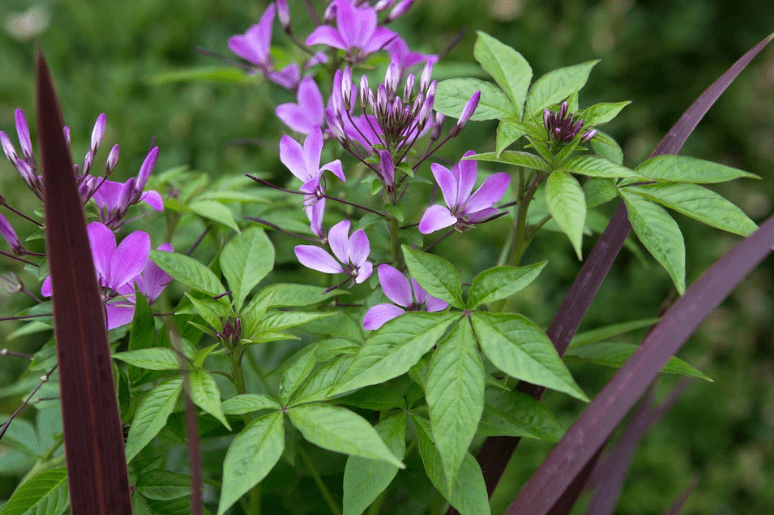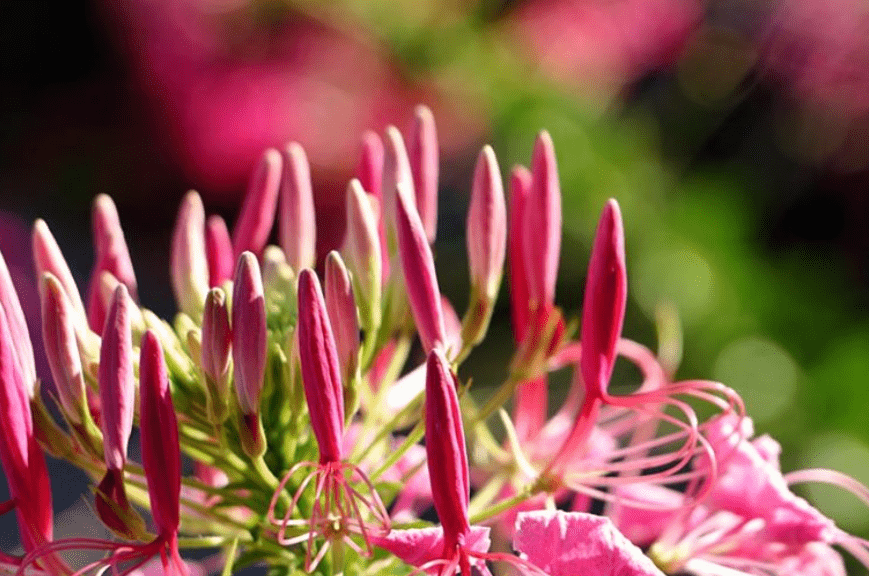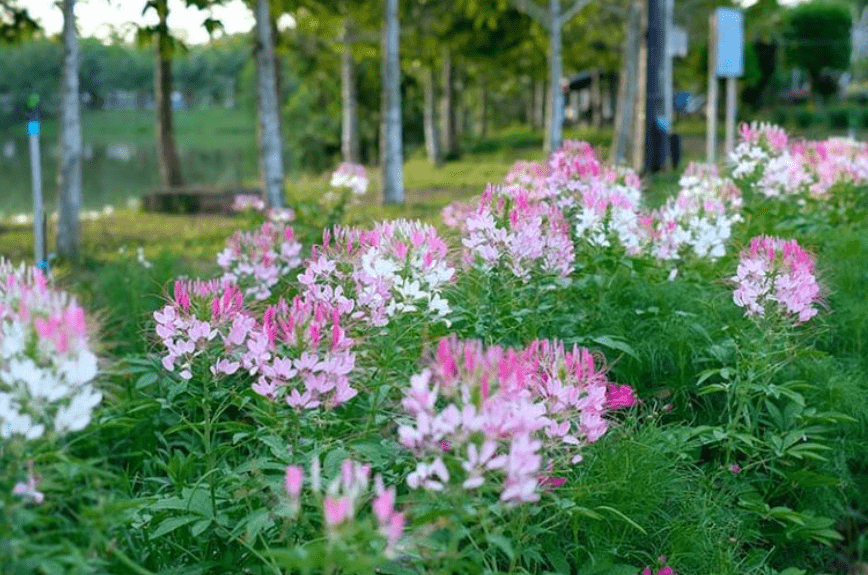
Cleome Plant: Growing Guide, Care Tips, and Benefits
Hey there, fellow plant enthusiasts! Are you looking to add a unique and beautiful plant to your garden? Well, look no further because in this post, we’re going to dive into everything you need to know about growing and caring for Cleome plants. Not only will we provide you with step-by-step care tips, but we’ll also discuss the benefits of adding Cleome to your garden. Whether you’re a seasoned gardener or just starting out, this comprehensive guide will give you all the information you need to successfully grow and care for Cleome plants. So, grab your gardening gloves and let’s get started!
Table of Contents
ToggleWhat is a Cleome Plant?
Detailed description of the cleome plant
The Cleome plant, also known as the spider flower, is a unique and eye-catching addition to any garden. This annual plant can grow up to 5 feet tall and features delicate, spider-like flowers in shades of pink, white, and purple. The foliage is also attractive, with palmate leaves that add texture and interest to the garden.
Growing and Care Tips:
Cleome plants are easy to grow and care for, making them a great option for both beginner and experienced gardeners. They prefer full sun and well-drained soil, and they are relatively drought-tolerant once established. Planting them in a sunny spot with good air circulation will help prevent powdery mildew, a common issue with Cleome plants.
When it comes to watering, Cleome plants prefer to be kept evenly moist but not waterlogged. Regular deadheading of spent flowers will promote continuous blooming throughout the growing season. Additionally, fertilizing with a balanced fertilizer every 4-6 weeks will help promote healthy growth and abundant flowers.
Benefits of Cleome Plants:
In addition to their stunning appearance, Cleome plants also offer several benefits to the garden. The flowers are attractive to pollinators such as bees and butterflies, making them a great choice for wildlife-friendly gardens. Their tall, airy growth habit also adds vertical interest to the garden and can be used as a backdrop for shorter plants.

Origin and natural habitat
Cleome plants are native to South America and are commonly found in open, sunny areas with well-drained soil. They thrive in warm climates and are known for their ability to attract pollinators such as bees and butterflies. By planting them in a sunny spot with good air circulation, you can prevent powdery mildew and ensure their healthy growth. Keeping the soil evenly moist without overwatering, regular deadheading of spent flowers, and fertilizing with a balanced fertilizer every 4-6 weeks will help promote continuous blooming and healthy growth. These stunning plants not only add beauty to your garden but also contribute to the overall ecosystem by attracting pollinators and adding vertical interest to your garden. So, if you want to enhance the beauty and biodiversity of your garden, consider adding Cleome plants to your landscape.
Different species and varieties
Different species and varieties of Cleome plants offer a wide range of options for gardeners. From the classic pink and white flowers of the Cleome hassleriana to the vibrant colors of the Cleome spinosa, there is a diverse selection to choose from. With their tall, airy growth habit, Cleome plants add vertical interest to the garden and can be used as a backdrop for shorter plants. Their unique appearance and ability to attract pollinators make them a valuable addition to any garden. Whether you’re looking for a splash of color or a way to support local wildlife, Cleome plants are an excellent choice. Embrace the beauty and biodiversity that Cleome plants bring to your garden and make a positive impact on the environment.
Benefits of Growing Cleome Plants
Aesthetic appeal and landscaping uses
Cleome plants offer a plethora of benefits to gardeners and the environment alike. Their aesthetic appeal adds a beautiful touch to any garden, with a wide range of colors and varieties to choose from. Their tall and airy growth habit also adds a unique vertical interest to your landscape, creating a stunning backdrop for shorter plants. Additionally, Cleome plants attract pollinators, supporting local wildlife and promoting biodiversity in your garden. By incorporating Cleome plants into your landscaping, you not only enhance the beauty of your garden, but you also contribute to the overall health of the environment. So, if you want to elevate the beauty and biodiversity of your garden, consider adding Cleome plants to your landscape and reap the countless benefits they have to offer.
Attracting pollinators: bees, butterflies, and hummingbirds
Are crucial pollinators that play a vital role in the ecosystem. By planting Cleome plants in your garden, you can attract these beautiful and beneficial creatures, supporting their populations and helping to maintain the balance of nature. Bees, in particular, are essential for the pollination of many food crops, making their presence in your garden not only aesthetically pleasing but also crucial for food production. By creating a welcoming environment for these pollinators, you are contributing to the health and diversity of local ecosystems. So, why not make a positive impact on the environment and attract these wonderful pollinators by planting Cleome plants in your garden? It’s a simple and rewarding way to support biodiversity and enjoy the beauty of nature.
Low maintenance and drought tolerance
Are two of the key benefits of adding Cleome plants to your garden. These beautiful flowers require very little care, making them the perfect choice for busy gardeners or those looking for an easy-to-care-for addition to their landscape. Cleome plants are known for their ability to thrive in dry and hot conditions, making them an ideal choice for areas with limited rainfall or drought-prone climates. By planting Cleome, you can enjoy a stunning display of flowers without the need for constant watering or maintenance. This not only saves you time and effort but also conserves water and reduces your overall environmental impact. So, if you want to enjoy the beauty of colorful flowers in your garden without the hassle of high maintenance, Cleome plants are the perfect choice. They are a low-maintenance, drought-tolerant option that will add beauty and vibrancy to your outdoor space with minimal effort on your part. So go ahead and add Cleome plants to your garden to enjoy their low-maintenance and drought-tolerant benefits while enhancing the beauty of your landscape.
How to Plant Cleome
Choosing the right location (sunlight, soil type)
When it comes to planting Cleome, choosing the right location is crucial for their success. These beautiful flowers thrive in full sunlight and well-drained soil, so be sure to plant them in an area that receives plenty of sunshine throughout the day. Additionally, make sure the soil is well-drained and not waterlogged, as Cleome plants do not do well in overly wet conditions.
By selecting the optimal location for your Cleome plants, you can ensure that they receive the sunlight and soil conditions they need to thrive. This will result in healthy, vibrant flowers that will bring beauty and color to your garden without requiring excessive maintenance.
So, take the time to carefully choose the right location for your Cleome plants, and you’ll be rewarded with a stunning display of low-maintenance, drought-tolerant flowers that will enhance the beauty of your outdoor space.

Planting from seeds vs. transplants
Are a great option for those who want to see immediate results in their garden. They are already established and can start growing right away. However, planting from seeds can be a rewarding and cost-effective option. It allows you to experience the full growth process from start to finish and gives you a sense of accomplishment as you watch your seeds sprout and grow into beautiful plants. Plus, you have more control over the growing conditions and can ensure that your plants are healthy and strong from the very beginning. Whether you choose to plant from seeds or transplants, both options have their own unique benefits. It ultimately depends on your personal gardening preferences and the level of involvement you want in the growing process. No matter which method you choose, the most important thing is to ensure that your Cleome plants have the right location, sunlight, and soil conditions to thrive. By taking these factors into consideration, you can enjoy a beautiful and flourishing garden filled with stunning Cleome flowers.
Step-by-step planting guide
Planting your own garden can be a fulfilling and rewarding experience. Whether you are a seasoned gardener or a beginner, having a step-by-step planting guide can be extremely helpful in ensuring that your plants thrive. By following a planting guide, you can learn the best practices for preparing the soil, sowing the seeds, and caring for your plants as they grow. This will give you the confidence and knowledge you need to create a beautiful and successful garden.
First, start by choosing the right location for your garden. Consider the amount of sunlight and shade the area receives, as well as the quality of the soil. Once you have identified the perfect spot, it’s time to prepare the soil. Remove any weeds, rocks, or debris, and ensure that the soil is well-drained and nutrient-rich.
Next, you will need to decide whether you want to plant from seeds or transplants. Both options have their own benefits, but planting from seeds allows you to experience the full growth process and have more control over the growing conditions. If you choose to plant from seeds, be sure to follow the instructions on the seed packet for the best results.
After planting your seeds or transplants, it’s important to provide the right amount of water, sunlight, and nutrients for your plants to thrive. Regularly check on your garden and make any necessary adjustments to ensure that your plants are healthy and strong.
By following a step-by-step planting guide, you can set yourself up for success and create a beautiful garden that you can be proud of. So, roll up your sleeves, get your hands dirty, and start planting! Your garden will thank you for it.
Caring for Your Cleome Plant
Watering requirements
When it comes to watering your plants, it’s important to find the right balance. Overwatering can lead to root rot, while underwatering can cause your plants to wilt and die. To ensure that your garden thrives, make sure to water your plants deeply and infrequently. This will encourage strong root growth and help your plants become more resilient to drought. It’s also important to water your plants in the morning or evening to reduce evaporation and make sure that your plants are able to absorb the water. By following these watering requirements, you can help your plants grow and flourish, creating a beautiful and vibrant garden for you to enjoy. So, don’t forget to water your plants and watch them thrive!
Fertilization tips
Fertilization is an essential aspect of plant care that can help your plants grow healthy and strong. There are a few key tips to keep in mind when fertilizing your plants. First, it’s important to choose the right type of fertilizer for your specific plants. Different plants have different nutritional needs, so be sure to select a fertilizer that is tailored to the needs of your plants. Additionally, be mindful of the timing and frequency of fertilizing. Over-fertilizing can harm your plants, so it’s important to follow the instructions on the fertilizer packaging and avoid excessive application. Finally, make sure to properly water your plants after fertilizing to help the nutrients penetrate the soil and reach the roots. By following these fertilization tips, you can ensure that your plants receive the nutrients they need to thrive and grow beautifully. So, take the time to fertilize your plants and watch them flourish before your eyes!

Pruning and deadheading
are essential practices for maintaining the health and beauty of your plants. Pruning helps to remove dead or overgrown branches, which allows for new growth and keeps the plant looking its best. Deadheading, on the other hand, involves removing spent flowers to encourage the growth of new blooms. Both of these practices help to promote the overall health and vitality of your plants.
When it comes to pruning, it’s important to use the right tools and techniques to avoid causing damage to the plant. Make sure to use sharp, clean cutting tools to make precise cuts and avoid tearing the plant’s tissue. Additionally, be sure to prune at the right time of year for the specific plant you are working with. Some plants benefit from pruning in the spring, while others may do better with fall pruning.
For deadheading, it’s important to remove spent flowers before they have a chance to go to seed. This helps to redirect the plant’s energy into producing new blooms, rather than expending energy on seed production. Be sure to deadhead regularly to keep your plants looking their best and encourage continuous blooming throughout the season.
Managing pests and diseases
In your garden is crucial to maintaining healthy plants and a beautiful landscape. It’s important to take a proactive approach to prevent and control pests and diseases before they become a major problem. Regularly inspect your plants for signs of pests and diseases, and take action at the first sign of trouble. There are many natural and organic methods for controlling pests and diseases, such as using beneficial insects, companion planting, and homemade remedies. By being attentive and proactive, you can prevent the need for harsh chemical treatments and keep your garden thriving. Remember, a healthy garden starts with proper pest and disease management.
Seasonal Care for Cleome Plants
Spring planting and preparation
Is crucial for a successful and bountiful garden. As the weather warms up, it’s time to start thinking about planting and preparing your garden for the upcoming season. Start by clearing away any debris or dead plants from the winter months to make room for new growth. Prepare the soil by adding compost or fertilizer to give your plants the nutrients they need to thrive. When planting, be sure to space your plants properly to allow for adequate air circulation and growth. Water your plants regularly and pay attention to any signs of pests or disease. By taking the time to properly prepare and care for your garden in the spring, you can set yourself up for a beautiful and productive growing season. So go ahead, roll up your sleeves and get your hands dirty – your garden will thank you for it!
Summer care and blooming season
Is a crucial time for your garden. It’s important to take the necessary steps to ensure that your plants are healthy and thriving during this time. Start by providing enough water to your plants, especially during the hot summer months. It’s also important to provide some shade for your plants to prevent them from getting scorched by the sun. Be sure to remove any dead or wilted flowers to encourage new growth and blooms. Fertilize your plants as needed to provide them with the nutrients they need to flourish. Keep an eye out for any signs of disease or pests and take action to address them promptly. By taking the time to care for your garden during the summer, you can enjoy a beautiful and vibrant outdoor space for the season. So, roll up your sleeves and get to work – your garden will reward you with stunning blooms and lush greenery.
Fall maintenance and winter preparation
Are crucial for the health and longevity of your garden. As the seasons change, it’s important to take the necessary steps to prepare your garden for the colder months ahead. Start by cleaning up any leaves and debris from your garden beds and lawn. This will help prevent mold and disease from spreading and allow your plants to thrive. It’s also important to prune back any dead or overgrown branches to promote healthy growth in the spring. Consider adding a layer of mulch to your garden beds to insulate the soil and protect the roots of your plants during the winter. Additionally, make sure to bring any sensitive plants indoors or cover them with protective materials to shield them from frost and freezing temperatures. By taking the time to care for your garden now, you can ensure that it will be ready to flourish when spring arrives. So, don’t put off your fall maintenance and winter preparation – your garden will thank you for it!
Common Problems and Solutions
Identifying and treating common pests (e.g., aphids, spider mites)
Identifying and treating common pests in your garden is crucial for the health and well-being of your plants. Aphids and spider mites are two common pests that can wreak havoc on your garden if left untreated. They can suck the sap from your plants, causing them to wilt and die. To combat these pests, you can use natural remedies such as neem oil or insecticidal soap to control their population. In addition, introducing beneficial insects like ladybugs or lacewings can help to keep these pests in check. Regularly inspecting your plants for signs of infestation and taking proactive measures to address the issue will ensure the health and vitality of your garden. Don’t let these pests take over – take action and protect your plants today!

Dealing with common diseases (e.g., powdery mildew)
Dealing with common diseases like powdery mildew can be frustrating, but with the right approach, you can effectively manage and prevent the spread of these diseases in your garden. One way to combat powdery mildew is to remove and dispose of infected plant parts to prevent the spread of the disease. Additionally, applying fungicides or using natural remedies like milk or baking soda can help to control the spread of powdery mildew. It’s important to also practice good garden hygiene by properly spacing plants to allow for air circulation and avoiding overhead watering, as these practices can help to minimize the risk of powdery mildew. By taking proactive measures to address common diseases and pests, you can ensure the health and vitality of your garden. Don’t let these challenges discourage you – with the right knowledge and action, you can effectively manage and overcome common garden issues.
Troubleshooting growth issues (e.g., leggy plants, poor flowering)
Having trouble with leggy plants or poor flowering in your garden? Don’t let these issues discourage you. There are steps you can take to troubleshoot and address these growth problems. One common cause of leggy plants is inadequate sunlight, so be sure to provide your plants with the proper amount of light they need to thrive. Additionally, you can prune your plants to encourage bushier growth and improve overall appearance.
If you’re facing issues with poor flowering, it could be due to factors such as nutrient deficiencies or improper watering. Make sure your plants are receiving the necessary nutrients and water to support healthy flowering. Consider adding fertilizer or adjusting your watering schedule to address these issues.
It’s important to stay proactive in addressing growth issues in your garden. By taking the time to troubleshoot and address these challenges, you can help your plants thrive and ensure a successful garden. Don’t let these pests take over – take action and protect your plants today!
Companion Planting with Cleome
Best companion plants for cleome
Include marigolds, alyssum, and snapdragons. These plants not only complement the beautiful flowers of cleome but also help to repel pests and attract beneficial insects. Marigolds, in particular, are known for their ability to deter nematodes and protect your garden from harmful pests. Alyssum and snapdragons, on the other hand, attract beneficial insects such as bees and butterflies, which can help to pollinate your cleome plants and promote healthy growth.
In addition to choosing the right companion plants, it’s important to pay attention to the overall care and maintenance of your cleome plants. Proper pruning and watering are essential for promoting healthy growth and vibrant flowers. Additionally, keep an eye out for common issues such as nutrient deficiencies and pests, and take proactive measures to address these challenges.
By choosing the best companion plants and providing proper care for your cleome, you can create a beautiful and thriving garden that will be the envy of your neighborhood. Don’t let your cleome plants struggle on their own – give them the support they need with the right companion plants and attentive care.
In conclusion, adding Cleome plants to your garden can bring a beautiful burst of color and attract beneficial pollinators. By following our care tips and growing guide, you can ensure that your Cleome plants thrive and enhance the overall beauty of your garden. Plus, the benefits of having these stunning plants in your outdoor space are numerous, making them a worthwhile addition to any garden. So, why wait? Start growing and caring for Cleome plants today and reap the rewards of a vibrant and flourishing garden.
Frequently asked questions And Answer
Cleome plants are not only beautiful, but they also attract butterflies and hummingbirds to your garden. They can also help repel pests and add a pop of color to your outdoor space.
Cleome plants thrive in well-drained soil and full sun. Make sure to water them regularly, especially during dry spells, and deadhead the flowers to encourage more blooms.
Cleome plants are annuals and are best suited for warmer climates. If you live in a colder climate, you can try starting them indoors and transplanting them outside once the weather warms up.
Yes, Cleome plants are relatively easy to grow as long as you provide them with the right conditions. They are low-maintenance and can add a unique touch to any garden.
Cleome plants can grow anywhere from 3 to 6 feet tall, adding a dramatic and eye-catching element to your garden landscape.
Cleome plants can self-seed and spread if not properly managed. It’s important to keep an eye on them and remove any unwanted seedlings to prevent them from taking over your garden.
Cleome plants prefer well-drained, fertile soil. Adding organic matter to the soil can help improve its texture and provide the plants with the nutrients they need to thrive.
Cleome plants are relatively resistant to pests and diseases, making them a low-maintenance addition to your garden. However, it’s still important to keep an eye out for any issues and address them promptly.
